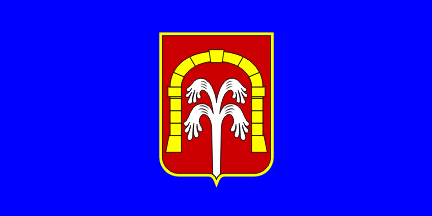
image by Željko Heimer, 19 December 2009

Last modified: 2010-02-19 by dov gutterman
Keywords: sisak | sisacko-moslavacka | topusko |
Links: FOTW homepage |
search |
disclaimer and copyright |
write us |
mirrors

image by Željko Heimer, 19 December 2009
See also:
Other sites:
Topusko is a community in the Sisak-Moslavina County, in its
south-western part, or if you preffer, at the top of the
north-western "peak" of Bosnia and Herzegovina, on the
rivar Glina at the half way between the city of Glina and its
confluence into Una at the border with B&H, between the
traditional regions named Kordun and Banovina. The community has
some 3200 inhabitants, which is about half then before the 1990's
war, the town of Topusko itself has no more then 800 people,
others living in 15 villages surrounding it. There are now about
30% of Serb population, that was in large majority before 1990.
In the Roman period it was known as Ad Fines. In the vicinity at
Petrova Gora mountain in a battle of 1097 the last Croatian
national king Petar Svacic was killed (afterwards Croatia was
ruled by kings of Hungarian then Austrian then Serbian
origin...). A legend says that the name of the town originates
from word 'canon' (top), which were used by the Turks in 1556 to
demolish a Cistercite monastery that was standing near by - built
by king Andrew II after his vow to build it if he returns
sucessfully from the crusade to Jerusalem. Only the monumental
Gothic portal is still standing, today a recognizable symbol of
the town. After the liberation from Ottomans, Topusko is part of
the Military Frontier. In early 19th century a health spa tourism
began to form using thermal springs, when the town flourishes. In
WWII the 3rd session of ZAVNOH, the anti-fascist government
assembly was held in May 8-9, 1944, establishing the Federate
State of Croatia as part of the Federative Yugoslavia - the
modern Republic of Croatia considers to be sucessor of the state
established there. During the Homeland war the town was held by
secessionist forces, much of the population was relocated and it
suffered much demolition. The Sector North HQ of UNPROFOR was
located in Topusko 1992-1995.
The community adopted symbols by a decision of 3
September 2008, pulished in the official gazette in mid-2009
(possibly the approval from the central authorities was being
waited for, but there is no mention of that in the gazette):
Odluka o grbu i zastavi Opcine Topusko, 03.09.2008, Službeni
vjesnik, br. 18/2009, 24.06.2009.
The same description of the symbols is also included in the
Articles 4 though 6 of the 2009 Statutes: Statut Opcine Topusko,
08.09.2009, Službeni vjesnik, br. 34/2009, 11.09.2009.
The above mentioned decision was amended soon, changing only
minor wording regarding the competences of the mayor: Odluka
izmjenama i dopunama Odluke o grbu i zastavi Opcine Topusko,
27.10.2009, Službeni vjesnik, br. 43/2009, 10.10.2009.
The coat of arms is: gules a masoned portal or and a
spring-fountain issuant from the base.
The portal is standing for the remaining Gothic portal of the
Cistercite monastery, the spring refers to the thermal spas. I
wonder weather the choice of the red background may be a subtle
reference to the Communist-lead ZAVNOH, although that may be a
simple coincidence.
The flag is blue with the coat of arms bordered yellow in the
centre of it.
The design surely looks like it might have been prepared by the
Heraldic Art company of Rijeka, and if so, we may also expect a
ceremonial flag which is not mentioned in the decision itself.
Željko Heimer, 19 December 2009
sk-to.gif)
image by Željko Heimer, 19 December 2009